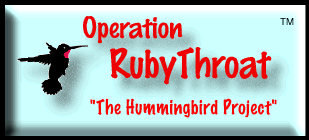 home: www.rubythroat.org |
|
 home: www.rubythroat.org |
|
|
| The tongue (right) of the Ruby-throated Hummingbird is split (below right) and somewhat broadened and brushy at the tip, allowing capillary action to draw in more fluid. A hummingbird laps up nectar with its tongue by extending and contracting it up to 13 times per second.
Hummingbirds do NOT use the tongue and bill as a straw. |
All photos & text © Bill Hilton Jr. & Operation RubyThroat |
Up to Top of Page
The Ruby-throated Hummingbird and its relatives have the most rapid metabolisms found in birds. The hummingbird digestive tract is a long tube through which food, then waste, passes quickly. The digestive tract consists of a short esophagus; a thin-walled and distensible crop (holding sac); soft proventriculus (where chemical digestion begins); a gizzard, or muscular stomach (mucous-secreting location for mechanical grinding of the hard parts of insects); a duodenum (where liver bile and pancreatic enzymes continue chemical digestion); a 5cm (2") small intestine (where digested nutrients are absorbed into the circulatory system); a large intestine (water re-absorption and temporary storage of wastes); and cloaca (a common area from which solid and liquid wastes and reproductive cells--egg and sperm--are released). The liver also stores lipids (fats) that can be released and metabolized quickly; lipids can make up 15% of the liver's weight in a Ruby-throated Hummingbird in mid-summer, and the level can rise to 45% just prior to migration. Hummingbirds do not have a gall bladder.
Up to Top of Page
The heart if the Ruby-throated Hummingbird (RTHU) and its relatives makes up about 2.5% of the bird's body weight, making relatively the largest heart in the animal kingdom. Hummingbirds also have the greatest concentration of oxygen-carrying red blood cells (erythrocytes). As in mammals, the heart of the RTHU, is four-chambered, with the right side receiving deoxygenated blood and pumping it to the lungs, and the left side receiving oxygenated blood from the lungs and pumping it to the body. Hummingbirds are unusual in that they all appear to lack the fourth aortic arch, requiring that the right ductus caroticus transport blood to the abdominal aorta.
The RTHU heart, on average, beats about 250 times per minute while at rest, and about 1,220 per minute while flying. On cool nights, the body temperature of hummingbirds can drop from a daytime norm of about 40.5 degrees C (105 F) to an overnight low of about 21 degrees C (70 F). This condition, known as "torpor," also allows the heart and breathing rate to slow and lowers basal metabolism so the hummingbird burns much less energy overnight.
Up to Top of Page
A Ruby-throated Hummingbird at rest breathes about 250 times per minute. Air enters the respiratory system through nostrils at the base of the bill and enters the small paired lungs. The lungs are connected to a complex system of air sacs that lie in spaces not occupied by other organs. As the hummingbird moves, pressure from its muscles forces air in and out of the air sacs, thus maximizing air flow when the bird is most active and most in need of fresh oxygen.
Up to Top of Page
The lymphatic system of the Ruby-throated Hummingbird is typical of birds. It functions in transporting lymph plasma (containing antibodies and other disease-fighting agents), and may also transport fats and waste.
Up to Top of Page
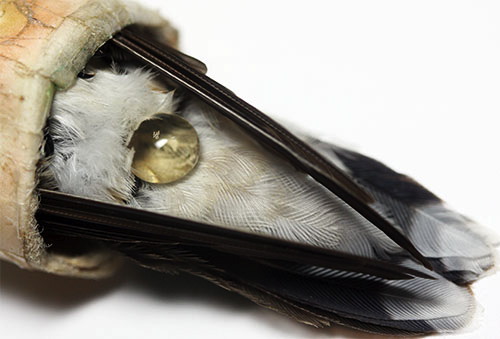
All photos & text © Bill Hilton Jr. & Operation RubyThroat
The Ruby-throated Hummingbird's excretory system is typical of other birds, with paired kidneys. Liquid waste separates from digestible items in the gastrointestinal tract and goes to the kidneys, where liquid waste and ammonia (converted to uric acid before reaching the kidneys) are filtered out. Urine travels from each kidney through the ureter to the cloaca, where it mixes with solid wastes. There is no urinary bladder--yet another weight-reduction mechanism that makes flight easier--and wastes are expelled as they are produced. A hummingbird captured for banding frequently produces one or more large droplets of clear, colorless urine (above); occasionally there are small dark bodies of solid waste (indigestible insect parts) within the droplet (see photo below).
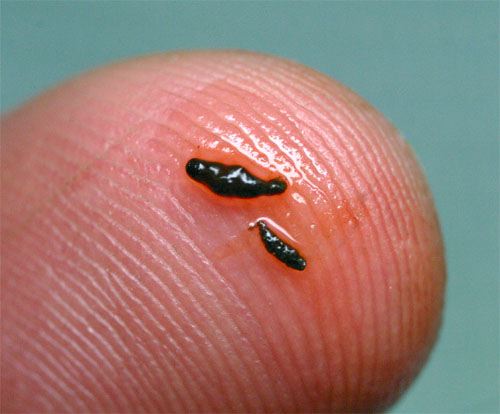
All photos & text © Bill Hilton Jr. & Operation RubyThroat
Up to Top of Page
Perhaps the most important muscles in Ruby-throated Hummingbirds are those associated with flying. These include the pectoralis majors (one left and one right) attached to the sternum and keel (see skeleton photos below), the upper wing bones (humerus), and the clavicles (fused at the tip to form the furcula, or wishbone). Pectoral muscles pull the wings down, causing forward motion of the bird. The wings are raised by the supracoracoideus muscles (right and left), which in hummingbirds are particularly large. (The elevator muscles are about 50% of the mass of the depressors, compared with 5-10% for most birds; thus, flapping up and down are equally important--as might be expected in a bird that hovers.) The supracoracoideus muscles are also attached to the sternum. These paired flight muscles make up about 25-35% of a hummingbird's overall weight, about 10% more than in other flying birds.
The pectorals and the supracoracoideus muscles are unusual in hummingbirds in that they contain all red muscle fibers and no white; other birds have at least some white fibers mixed in. Red fibers are adapted for sustained use, while white fibers allow for sudden, short-term energy bursts. Flightless birds such as domesticated chickens have breast muscles consisting of white fibers only.
Up to Top of Page
As in most birds, the reproductive organs (gonads) of the Ruby-throated Hummingbird are active only during the normal reproductive season. In fact, during non-breeding months, testes and ovaries of hummingbirds shrink to a tiny fraction of their active size. This is an apparent adaptation for flight since there's real disadvantage in carrying the extra weight of large, fully functioning gonads at a time when they are not needed--particularly during migration.
In the male, there is one testis beside each of the kidneys; the testis produces sperm that flow through the vas deferens (sperm duct) to the cloaca. The end of the vas is enlarged as the seminal vesicle, which temporarily stores sperm and produces a swelling of the vent referred to as a "cloacal protuberance." When hummingbirds mate, the male touches the tip of his cloaca to that of the female and sperm are transferred; there is no intromittent organ (penis). In the female, the right ovary atrophies early in her development and only the left one becomes functional; this, again, is an apparent adaptation for flight that allows a female to shed the extra weight of her "back-up" second ovary. As breeding season ensues, several ova mature within the ovary, produce a yolk, and are expelled into the oviduct. If the ovum is fertilized, it continues down the oviduct to the midway point where the albumen gland secretes protein-rich "egg white." Further along, two layers of shell membrane are laid down by the shell gland, and the outer layer--made mostly of calcium--hardens as the egg is ejected from the cloacal opening. Infertile ova are resorbed by the reproductive tract. Female hummingbirds almost always lay two eggs per clutch.
In many bird species, females (and some males) develop brood patches on their bellies when incubating eggs and brooding young. These patches form when the belly feathers fall out, the bare spot becomes edematous (filled with fluid), and the skin becomes more vascularized (laden with new capillaries). All this functions to create a sort of hot water bottle that more efficiently transmits the mother's body heat to her eggs and chicks. There is some debate whether the RTHU females develop a "brood patch"; we believe they do, although not to the extent found in many songbirds.
Up to Top of Page
The brain of the Ruby-throated Hummingbird, like that of other birds, is proportionally large for its body. The optic lobes, responsible for vision, are especially large, although the cerebrum (which controls learning) itself is somewhat small. The cerebellum, which controls instinctive behavior and muscle activity such as flight and balance, is relatively large. The autonomic (sympathetic and parasympathetic) and peripheral nervous systems are typical of birds. Unlike birds such as jays and parrots, which have large cerebral hemispheres and are capable of some degree of learning, hummingbirds may be considerably more dependent on instinct.
Up to Top of Page
Like most birds, Ruby-throated Hummingbirds apparently have no sense of smell; they lack olfactory nerve endings in their nasal cavities. Thus, they use their senses of taste and vision to find and identify nectar-producing flowers. The sense of taste is not well well-developed but is sufficient to allow a hummingbird to discriminate between solutions with relatively high or low sugar concentrations. As with most birds, vision is acute in hummingbirds because of the high density of rods (light sensors) and cones (color sensors) on the retina.

All photos & text © Bill Hilton Jr. & Operation RubyThroat
The eyes are relatively large--about 4-5mm (3/16") in diameter--and are set on the side of the head (see skull photo above), allowing the hummingbird to see both straight ahead and peripherally. Each eye (see photo below) is protected by a "third eyelid," the semi-transparent nictitating membrane that covers and protects the eye while the bird is flying. The "eyelashes" are tiny tufts of feathers.

All photos & text © Bill Hilton Jr. & Operation RubyThroat
Hummingbirds likely are attracted to red only because it is the color of so many nectar-producing tubular flowers; red has probably been selected for in these flowers because it contrasts significantly against the green coloration of their foliage. Hummingbirds appear to see other colors equally well and visit flowers of any color if there is nectar to drink. Hummingbirds probably see a little further into the infrared aand ultraviolet ranges than do humans.
As in most birds, the sense of touch is poorly developed; because the hummingbird is essentially covered by feathers, this does not seem to be a disadvantage. The sense of hearing has not been well-investigated in hummingbirds. Since they do respond to the sound of wing beats (humming) and chittering vocalizations of other hummingbirds, it is believed they have the acute hearing typical of other birds; it is not known whether they can discriminate between or among complex sounds such as elaborate bird song.
Up to Top of Page
Ruby-throated Hummingbirds, like other vertebrates, have ducted and ductless (endocrine) glands. Ductless glands secrete hormones that affect physiology and behavior, including feather molt, basic metabolism, reproductive development and readiness, digestion, and migrational tendencies. The oil-producing uropygial gland is unique to birds (see "Skin" below).
Up to Top of Page
The skin of the Ruby-throated Hummingbird is thin, elastic, and pink; skin on the wings and legs is black. Skin gives rise to follicles that produce feathers. The oil-producing uropygial gland on the upper surface of the uropygium (the rear appendage to which tail feathers are attached) is the primary skin gland (see "Glandular System" above).
Up to Top of Page
The skeleton of the Ruby-throated Hummingbird includes some solid bones, but most are porous or--in the case of the wing and leg bones--hollow. 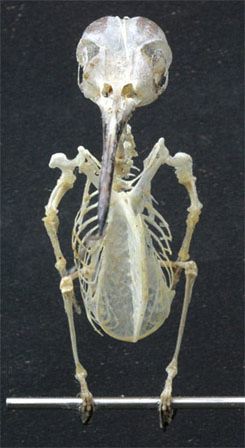 Most hummingbirds have eight pairs of ribs (most birds have only six pairs), and a deep keel (sternum, or breastbone) to which the pectoral (flight) muscles are attached. The keel is also much longer top to bottom than in most birds (see skeleton photos at right and below). The wing attaches to the sternum in a tiny ball-and-socket joint unique to hummingbirds and swifts and that allows the flexibility of wing movement required for the hummingbird's hovering and backwards flight. A hummingbird's exposed legs are extremely short, but have rather long toes (three in front and one--the hallux--in back). Humminbirds have 14 or 15 neck vertebrae--compared to just seven in most mammals.
Most hummingbirds have eight pairs of ribs (most birds have only six pairs), and a deep keel (sternum, or breastbone) to which the pectoral (flight) muscles are attached. The keel is also much longer top to bottom than in most birds (see skeleton photos at right and below). The wing attaches to the sternum in a tiny ball-and-socket joint unique to hummingbirds and swifts and that allows the flexibility of wing movement required for the hummingbird's hovering and backwards flight. A hummingbird's exposed legs are extremely short, but have rather long toes (three in front and one--the hallux--in back). Humminbirds have 14 or 15 neck vertebrae--compared to just seven in most mammals.
People often ask how many bones a hummingbird has in its skeleton, but there is no definitive answer. For instance, the bony ring that surrounds each eye is made up of 12 or more small bones (ossicles); there's no agreement as to whether each of these counts as an individual "bone" or whether the entire ensemble of ossicles (i.e., the bony ring) counts as a single bone. In addition, the skull is made up of many bones that in adults are more or less fused--also the case with the pelvic girdle--and there are even several small bones in a hummingbird's tongue apparatus. To further complicate the question, different hummingbird species have different numbers of ribs and toe bones.
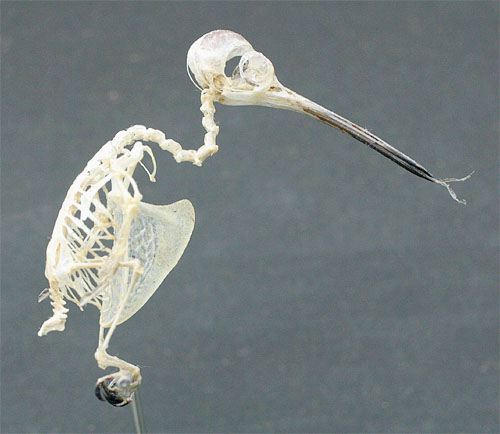
All photos & text © Bill Hilton Jr. & Operation RubyThroat
Above is a photo of a Ruby-throated Hummingbird skeleton, prepared by Stanlee Miller of Clemson University. It reveals a characteristic of all hummingbirds: the large sternum (keel) to which the large pectoral (breast) muscles are attached. Also visible are the wing bones--in which the fused bones of the hand are most obvious--and the hyoid bones of the tongue, which wrap around the base of the bird's lower jaw and skull and insert in its forehead. Note that in this partcular skeleton the tongue--split at the tip--protrudes slightly; in a live bird the tongue is hidden within the bill.
By comparison, pictured below is the skeleton of a Sword-billed Hummingbird, Ensifera ensifera, a species that occurs on the high Andes Mountains. It is the only bird with a bill longer than its body.

All photos & text © Bill Hilton Jr. & Operation RubyThroat
Sword-billed Hummingbird skeleton photo courtesy The Slater Museum of Natural History
Up to Top of Page
Up to Top of Page
|
Make direct donations on-line through
Network for Good: |
 |
|
LIKE TO SHOP ON-LINE?
Donate a portion of your purchase price from 500+ top on-line stores via iGive: |
|
|
Use your PayPal account
to make direct donations: |
|
|
|
Share Your Hummingbird Experiences Through "Hummingbird Hobnob" |
 |
Operation |
|
|